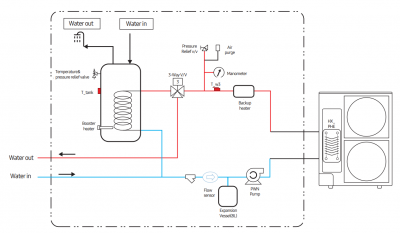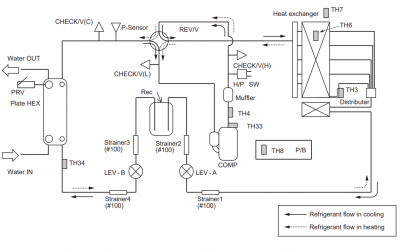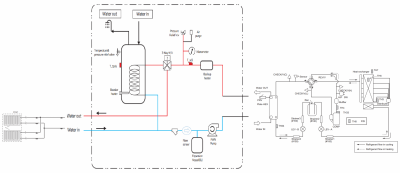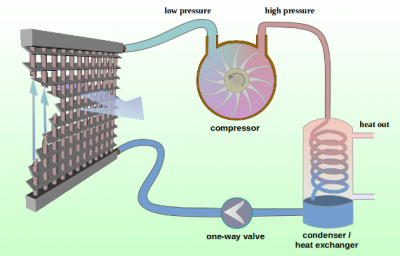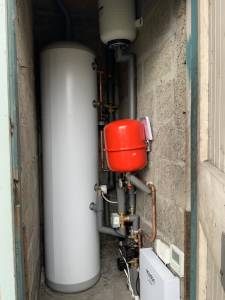Posted by: @amanda1@derek-m Hokay - please could you explain to what part of this process do the terms Flow Temperature and Return Temperature apply? (if they do). And why is it considered more economical for flow temperature to be as low as possible? And what is in those insulated two big pipes connecting the pump to my house - one with a blue lever, the other with a red lever. Is it fluid?
Assuming that you have a monobloc heat pump, the two insulated pipes will be carrying the water, or water antifreeze mixture, into your home.
The Flow temperature, often called Leaving Water Temperature (LWT), is the temperature of the warm water coming out of your heat pump and being supplied to the heat emitters or hot water cylinder.
The Return Temperature or Return Water Temperature (RWT) is the temperature of the water going back to the heat pump from the heat emitters or hot water cylinder.
When the heating system is working normally, the LWT should be approximately 5C higher than the RWT.
The water is heated by the refrigerant gas, which of course needs to be warmer than the water for thermal energy transfer to take place. If the heat pump is warming the water to a higher LWT, then the compressor will need to work harder, which in turn will use more electrical energy. It is therefore normally more efficient to operate the heat pump at the lowest LWT that meets the heat demand of your home.
Posted by: @amanda1@derek-m Hokay - please could you explain to what part of this process do the terms Flow Temperature and Return Temperature apply? (if they do). And why is it considered more economical for flow temperature to be as low as possible? And what is in those insulated two big pipes connecting the pump to my house - one with a blue lever, the other with a red lever. Is it fluid?
@amanda1 Yes, a lot of things happen inside that monobloc case! However, it is a well proven invention as we have been using refrigerators for many many years! The ‘fridge is delivered and apart from letting it stand for a while for the gas to settle before switching on and enjoying food storage advantages for some years without need to service the appliance; the heat pump needs installing with care / skils and requires setting up and if like many people on this forum know, their users take a great deal of care to ensure they are running as efficiently as possible. Of course they are normally outside and exposed to the elements and require servicing on a regular basis… Regards, Toodles.l
Toodles, heats his home with cold draughts and cooks food with magnets.
@amanda1 - I can offer a diagram which is somewhat less daunting, if it helps.
I'll assume that you are a teacher by profession.
Please feel free to comment if any of us are going too deep into technicalities.
Disseminating useful information must be a principle reason for the existence of this forum.
Save energy... recycle electrons!
@transparent thanks - I am assuming the compressor is inside the Monobloc? But is the condenser in there as well? What is the small red cylinder for?
@amanda1 Mine was after 12 years without even a service 🙂
House-2 bed partial stone bungalow, 5kW Samsung Gen 6 ASHP (Self install)
6.9 kWp of PV
5kWh DC coupled battery
Blog: https://thegreeningofrosecottage.weebly.com/
Heatpump Stats: http://heatpumpmonitor.org/system/view?id=60
I'm adding annotations to your photo, @amanda1
But is that cupboard within the heated envelope of the house or outside?
Save energy... recycle electrons!
@amanda1 This tank is used to apply a pressurised water feed to your circulating heating water. Normally the tank ispressurised from the water main to 1 - 1.5 bar; the tank contains a membrane (rubber or more modern equivalent?) so that the pressure is held and it is shown on a pressure guage attached to the tank. Normally the water main supply is isolated from the tank by two stop valves. Should the pressure drop (due to very slight leaks or evaporation etc., the tank pressure is topped up by opening the two stop valves until the pressure guage shows a level of pressure withing the red region - then the valves should be shut again. Sudden loss of pressure is however, an indication that there is a need for attention to the system. Regards, Toodles.
Toodles, heats his home with cold draughts and cooks food with magnets.
@amanda1 The red cylinder looks like an expansion tank, which will probably be on the central heating/hot water circuit. The CH/HW circuit will probably be a sealed system pressurised to 1 or 2 Bar, there should be a gauge and a filling loop as well. The expansion tank will regulate the water pressure as it expands and contracts over temperature. Old fashioned open systems had a tank in the loft.
I believe that all of the components of a mono block heat pump are in the one unit. There are also split designs in which only the fan and heat exchanger are outside and the rest is in another unit inside.
- 26 Forums
- 2,342 Topics
- 53 K Posts
- 253 Online
- 6,000 Members
Join Us!
Worth Watching
Latest Posts
-
That's a similar sized house to mine, also fully insula...
By KevH , 19 minutes ago
-
RE: Configuring third party dongle for Ecodan local control
@majordennisbloodnok I think the HPDHD diagnosis may be...
By Sheriff Fatman , 52 minutes ago
-
RE: Are We Sleepwalking Into Another Race to the Bottom?
@editor how about a video "ChatGPT vs average heating e...
By ksim , 1 hour ago
-

RE: External pipework insulation
I don't think we can tell from a photo whether your exi...
By Transparent , 1 hour ago
-
-
RE: Controlling Daikin Altherma via P1P2 and Home Assistant
@majordennisbloodnok That’s correct. I can’t find anywh...
By weoleyric , 7 hours ago
-
RE: Octopus Cosy Heat Pump Owners & Discussion Thread
@andrewj yeah we recreated it. Engineer seemed to think...
By swwils , 8 hours ago
-

RE: Setback savings - fact or fiction?
@robs — thanks again for your detailed comments. Some r...
By cathodeRay , 1 day ago
-

RE: A Smarter Smart Controller from Homely?
@papahuhu I hope you get a swift resolution. Regards, T...
By Toodles , 1 day ago
-

RE: Poll for Time of Use, tariffs, technology
That’s fine by me too Major, I feel it is a sad reflect...
By Toodles , 1 day ago
-

Bingo. Sometimes a judiciously placed size 10 bovver bo...
By Majordennisbloodnok , 1 day ago
-
RE: Mitsubishi Ecodan 11.2kW heat pump with low COP
@ciocoiu-alexandru I can't provide the same level of di...
By Sheriff Fatman , 1 day ago
-

The three technical issues I'm considering are: BMS...
By Transparent , 1 day ago
-
RE: LiFePO4 lithium battery fires and explosions
@transparent Your post may fit better in th...
By Batpred , 1 day ago
-

RE: British Gas vs Octopus Energy vs Heat Geek vs EDF vs Aira vs OVO vs EON.Next vs Boxt
@jamespawhite, if you could be bothered, you could also...
By Mars , 1 day ago
-
RE: Commencing on an ASHP Installation Process
I've got a bit of time to draft something today, so the...
By Sheriff Fatman , 2 days ago
-
RE: Help with heat pump sizing
@amin I dont think materially relative to t...
By JamesPa , 2 days ago
-

@majordennisbloodnok I have decided to take the plunge....
By TechnoGeek , 2 days ago

